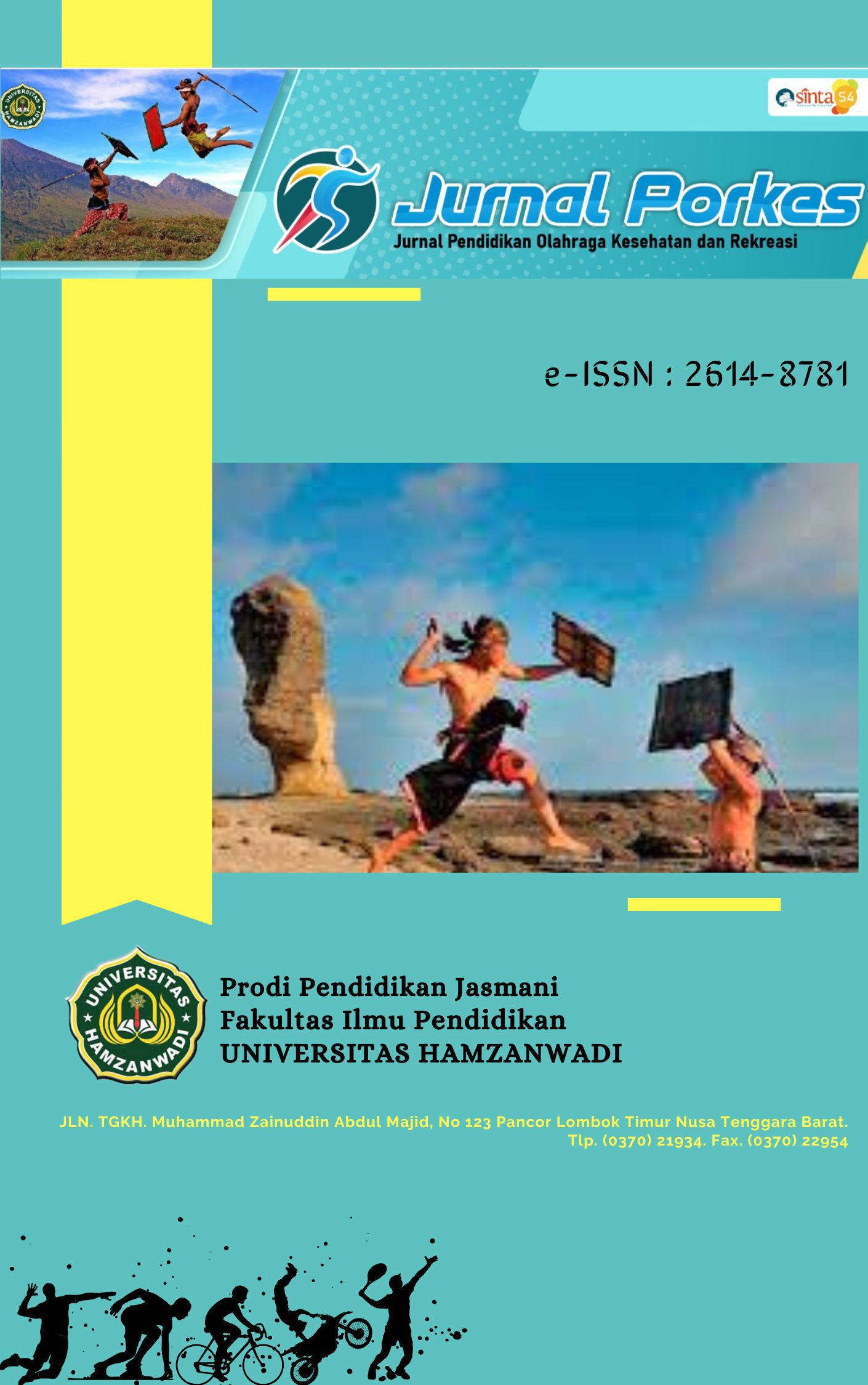Hubungan Aktivitas Fisik Terhadap Resting Heart Rate Remaja
DOI:
https://doi.org/10.29408/porkes.v8i2.30083Keywords:
Physical activity; cardiovascular; resting heart rateAbstract
The purpose of this study was to determine the relationship of physical activity to resting heart rate. This study used a quantitative descriptive method with a cross-sectional approach. Subjects in this research amounted to 50 students from the physical education health and recreation study program of STKIP Modern Ngawi. The sample was selected through the total sampling method. Data were analyzed descriptively and correlatively. The instrument used to collect data on the level of physical activity was the IPAQ-SF questionnaire and heart rate was measured by palpating the arterial blood vessels in the wrist and counting the number of beats per minute. The results of the resting pulse study obtained a minimum value of 41 beats per minute. Physical activity obtained a minimum value of 1122 MET-minutes / week, a maximum value of 4173 MET-minutes / week, and obtained an average of 2442.5 MET-minutes / week. The normality test using the Kolmogorov-Smirnov test shows that the significance of pulse rate p > 0.05, which is 0.63 > 0.05. The significance value of physical activity p > 0.05 which is 0.200 > 0.05. The conclusion in this study is that there is a relationship between physical activity and resting heart rate.
References
Alupo, C., & Lu, G. (2023). Physical Activities and How They Improve on Lifestyle. Library Journal, 10(11), 1–8. https://www.scirp.org/journal/paperinformation?paperid=129560
Andhi, S., Nurfitriani, R. A., Jusup, S. A., & Aryoseto, L. (2022). Hubungan Volume Oksigen Maksimal dengan Denyut Nadi Istirahat pada Usia Dewasa Muda. Jurnal Arteri, 3(4), 139–143. https://doi.org/10.37148/arteri.v3i4.237
Arta, R. D., & Fithroni, H. (2021). Hubungan Tingkat Stres dan Aktivitas Fisik Terhadap Kebugaran Jasmani pada Mahasiswa Semester Akhir di Universitas Negeri Surabaya. Jurnal Kesehatan Olahraga, 9(3), 261–270. https://ejournal.unesa.ac.id/index.php/jurnal-kesehatan-olahraga/article/view/41341
Chow, H.-W., & Yang, C.-C. (2020). Accuracy of Optical Heart Rate Sensing Technology in Wearable Fitness Trackers for Young and Older Adults: Validation and Comparison Study. Jmir Mhealth And Uhealth, 8(4). https://doi.org/10.2196/14707
Christopher, A., & Dinata, Y. M. (2022). Rancang Bangun Sistem Pemantauan Jarak Jauh Denyut Nadi, Saturasi Oksigen, dan Suhu Tubuh pada Orang Sakit di Rumah. Jurnal Informatika dan Sistem Informasi, 8(1), 1–11. https://doi.org/10.37715/juisi.v8i1.2619
Honório, S., Batista, M., & Silva, M. R. G. (2019). Physical Activity Practice and Healthy Lifestyles Related to Resting Heart Rate in Health Sciences First-Year Students. American Journal of Lifestyle Medicine, 16(1), 101. https://doi.org/10.1177/1559827619878661
IPAQ. (2004). Guidelines for data processing and analysis of the IPAQ-short and long forms. Med Sci Sports Exercise.
Jetté, M., Sidney, K., & Blümchen, G. (1990). Metabolic Equivalents (METS) in Exercise Testing, Exercise Prescription, and Evaluation of Functional Capacity. Clinical Cardiology, 13(8), 555–565. https://doi.org/10.1002/CLC.4960130809
Lang, J. J., Belanger, K., Poitras, V., Janssen, I., Tomkinson, G. R., & Tremblay, M. S. (2018). Systematic Review of the Relationship Between 20 m Shuttle run Performance and Health Indicators Among Children and Youth. Journal of Science and Medicine in Sport, 21(4), 383–397. https://doi.org/10.1016/J.JSAMS.2017.08.002
Mahdalena, M., Hutagaol, R., & Suroto, S. (2025). Peningkatan Kesehatan Lansia Mellui Senam Hipertensi Sebagai Intervensi Non-Farmakologis. Jurnal Widya Laksmi: Jurnal Pengabdian Kepada Masyarakat, 5(1), 39–45. https://jurnalwidyalaksmi.com/index.php/jwl/article/view/112
Mulya, N., Rahmawati, N. A., & Rahim, A. F. (2024). Aerobic Exercise Berpengaruh Terhadap Denyut Nadi Istirahat. Physiotherapy & Health Science (PhysioHS) Journal, 7(2), 39–44. https://doi.org/10.22219/physiohs.v7i2.38133
Novianto, M. A., Wibisana, M. I. N., & Wiyanto, A. (2021). Analisis Motivasi dan Tingkat Aktivitas Fisik Bersepeda di Masa Pandemi Covid-19 di Kabupaten Brebes. Jurnal Spirit Edukasia, 1(1), 83–96. https://journal.upgris.ac.id/index.php/spiritedukasia/article/view/9148
Nurmidin, M. F., Fatimawali, F., & Posangi, J. (2020). Pengaruh Pandemi Covid-19 Terhadap Aktivitas Fisik dan Penerapan Prinsip Gizi Seimbang pada Mahasiswa Pascasarjana. Jurnal Kesehatan Masyarakat dan Kedokteran Komunitas Indonesia, 1(4), 28–32. https://ejournal.unsrat.ac.id/index.php/ijphcm/article/view/31169
Otriami, I., Yanni, M., Reza, M., & Ilmiawati, C. (2021). Analisis Frekuensi Denyut Jantung Istirahat Pelari dan Bukan Pelari di Kota Padang. Jurnal Ilmu Kesehatan Indonesia, 2(1), 107–112. https://doi.org/10.25077/jikesi.v2i1.315
Purbianto, P., Agustanti, D., & Nasihin, N. (2024). Early Warning System pada Henti Jantung Berbasis Smartphone. Jurnal Kesehatan Vokasional, 9(1), 17–27. https://doi.org/10.22146/jkesvo.92777
Ramadhan, I., Nurfitriani, R. A., Jusup, S. A, & Aryoseto, L. (2022). Hubungan Volume Oksigen Maksimal dengan Denyut Nadi Istirahat Fase Pertumbuhan Dewasa Muda. Arteri : Jurnal Ilmu Kesehatan, 3(4), 139–143. https://doi.org/10.37148/arteri.v3i4.237
Samodra, Y. T. J., & Sudrazat, A. (2021). Denyut Nadi Indikator Istirahat dalam Kegiatan Sehari-Hari. Jurnal Pendidikan Kesehatan Rekreasi, 7(1), 150–159. https://ojs.mahadewa.ac.id/index.php/jpkr/article/view/1005
Sandi, I. N. (2013). Hubungan Antara Tinggi Badan, Berat Badan, Indeks Massa Tubuh, dan Umur Terhadap Frekuensi Denyut Nadi Istirahat Siswa SMKN-5 Denpasar. Jurnal Olahraga dan Kebugaran, 1(1), 38–44. https://ojs.unud.ac.id/index.php/sport/article/view/6069
Siahaan, P. P., Purwanto, B., Budiarto, R. M., & Irwadi, I. (2021). Physical Activity Level and Resting Heart Rate. Jurnal Ilmiah Kesehatan (JIKA), 3(1), 16–22. https://doi.org/10.36590/jika.v3i1.103
Solechah, S. A., Briawan, D., & Kustiyah, L. (2014). Proporsi dan Faktor Risiko Sindrom Metabolik pada Pekerja Wanita di Pabrik Garmen di Kota Bogor. Jurnal Penelitian Gizi dan Makanan, 37(1), 1–12. https://www.pgm.persagi.org/index.php/pgm/article/view/74
Supriyono, S., & Magdalena, M. (2023). Hubungan antara Aktivitas Fisik, Denyut Nadi dan Status Gizi Peserta Pelatihan Dasar Calon Pegawai Negeri Sipil Provinsi Jawa Tengah. Jurnal Ilmu Kesehatan Masyarakat, 12(5), 337–345. https://doi.org/10.33221/jikm.v12i05.1864
Suryoadji, K. A., & Nugraha, D. A. (2021). Aktivitas Fisik pada Anak dan Remaja Selama Pandemi Covid-19: Sebuah Tinjauan Sistematis. Khazanah: Jurnal Mahasiswa, 13(1), 24–29. https://doi.org/10.20885/khazanah.vol13.iss1.art3
Widya Handayani. (2025). Faktor-Faktor Risiko Penyakit Kardiovaskular : Artikel Review. Jurnal Pengembangan Ilmu dan Praktik Kesehatan, 4(3), 139–158. https://e-journal.lppmdianhusada.ac.id/index.php/PIPK/article/view/465
William, W., Susanto, N. G., & Rumiati, F. (2023). Gambaran Tingkat Aktivitas Fisik dan Kebugaran Kardiorespirasi (Vo2max) pada Karyawan PT Arwana Nuansa Keramik. Jurnal Medika Udayana, 12(1), 10–15. https://doi.org/10.24843/MU.2023.V12.i01.P03
Zaki, N. M., Amelia, T., Kamilah, S. N., & Larasaty, R. (2023). Deskripsi Prokrastinasi Akademik pada Siswa Kelas 9 SMP Negeri 27 Palembang. Proceeding Conference On Psychology and Behavioral Sciences, 2(1), 1–11. https://doi.org/10.61994/cpbs.v2i1.34
Zhang, D., Wang, W., & Li, F. (2016). Association Between Resting Heart Rate and Coronary Artery Disease, Stroke, Sudden Death and Noncardiovascular Diseases: a Meta-Analysis. National Library of Medicine, 15(22), 188. https://doi.org/10.1503/cmaj.160050.
Downloads
Published
How to Cite
Issue
Section
License
Copyright (c) 2025 Kartika Septianingrum, Aziz Fitriadi, Andy Widhiya Bayu Utomo

This work is licensed under a Creative Commons Attribution-ShareAlike 4.0 International License.
![]()
Jurnal Porkes is licensed under a Creative Commons Attribution-Share Alike 4.0 International License







